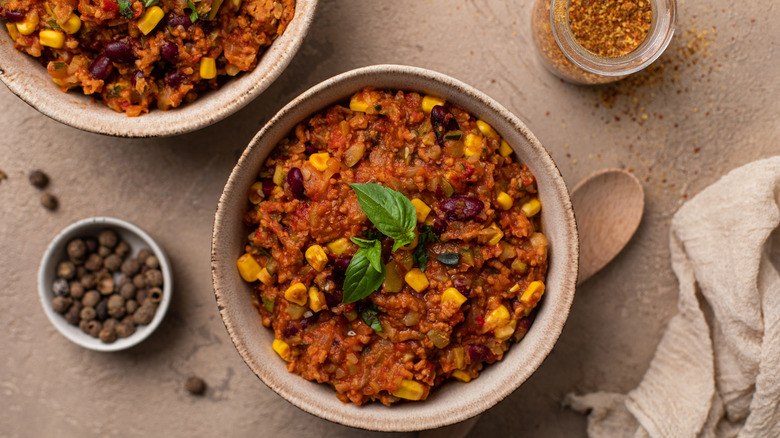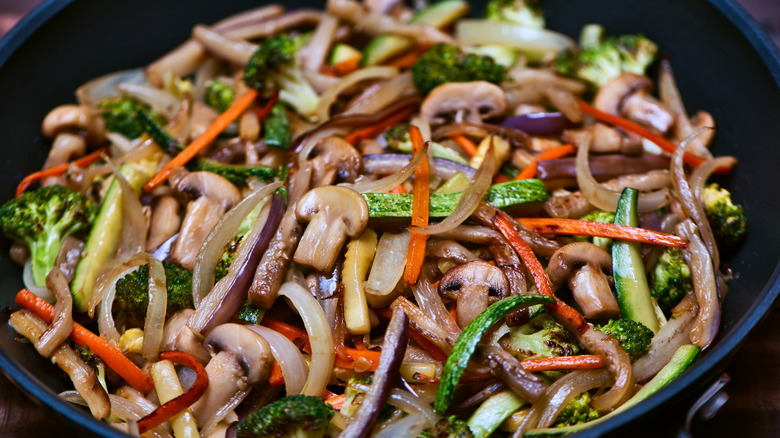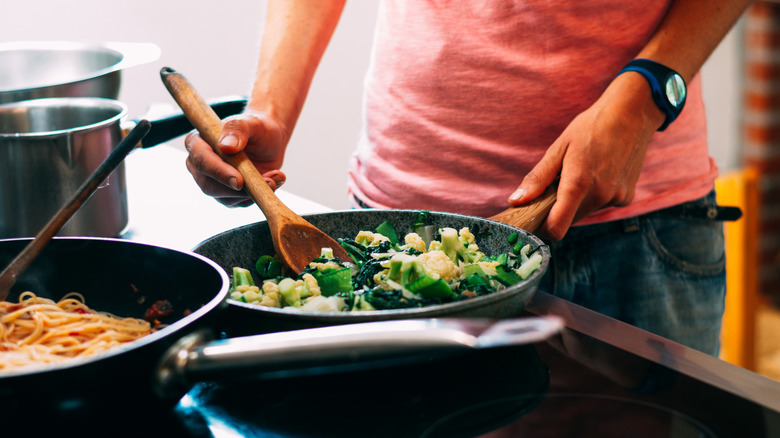Follow This Crucial Rule When Adding Vegetables To Chili
Sometimes, you can judge a successful chili by the number of times people pop their heads into the kitchen, guided by the wafts of a generously seasoned and deeply promising dish. Whether you go for a basic 3-bean vegetarian chili or something more on the traditional side, a chili that has depth, boldness, and all the right aromatics will be the centerpiece of any table it shows up on. When adding vegetables, it's important to remember that the way you prepare the veggies before they are added to the chili pot sets the tone for the dish's overall taste. For best results, sauté your vegetables first to ensure that your chili is anything but bland.
Sautéing is a go-to method for achieving a more integrated and well-layered chili that one-pot dishes can't compete with. Cooking chopped vegetables in oil draws out deeper flavor and aroma because the chemical reaction that occurs when you chop vegetables (i.e. when the cells are broken) and cook them causes the compound to change, leaving you with a softened and more flavorful vegetable. Making a chili without sautéing the vegetables first means you miss out on the added boost of tastiness that otherwise remains unreleased if you simmer them or add them to the pot raw. It doesn't just add some oomph to chili recipes either. Sautéing vegetables is also a crucial step when making soup, and it can be an effortless (and relatively simple) way to balance out the flavors.
Tips for sautéing vegetables when making chili
There are a few things to keep in mind when it comes to sautéing your veggies to maintain the texture, vibrancy, and taste that will make your chili stand out. Firstly, it's best to reach for your trusty skillet to provide a smooth and effective sautéing session. The wider your skillet, the more likely your veggies will get enough time to end up more evenly browned. Opt for a non-stick skillet to retain the shape of your vegetables and to ensure that they will slide out of the pan and into the main chili dish with ease.
If you don't have a non-stick skillet on hand, cast iron, stainless steel sauté pans, or aluminum frying pans work just as well. Remember that different vegetables require different amounts of time while sautéing, which means paying close attention to them during the process. You'll want to sauté onions until they are translucent, allow mushrooms to get lightly browned (about five minutes or so should do it) and you should aim to sauté garlic until golden brown.
Typically, sautéing vegetables over medium or medium-high heat is the way to go, always making sure not to add too much heavy oil for a sauté faux pas. The low oil content in the pan paired with the chopped veg in the confined space creates a pretty delicious combination. While you may want to pack the juicy vegetable texture into your chili, overcrowding the pan is a recipe for disaster as this locks in the steam, making it hard for the veggies to properly brown.
How to use the 'ground up' rule to properly sauté vegetables
There is one crucial step to adhere to if you want to brown vegetables like a pro — follow the all-important 'ground up' rule when sautéing veg. Yes, the order you choose to add your vegetables to the pan matters. The 'ground up' rule insists that you begin with root vegetables (grown in the ground), then add in the 'above the ground' vegetables, and then leafier, top of the plant vegetables. You do need to keep in mind that some vegetables tend to cook faster than others (looking at you, onions) so you may have to adjust to ensure you don't end up overdoing certain vegetables and spoiling your sauté efforts.
The rule is all about consistency, making sure each vegetable is cooked to the same level so that you don't have to flick through burnt onions or soggy eggplant. It is also a good idea to add dried seasonings midway through sautéing since they are more potent. Hold back on fresh herbs until the very end so you can preserve their color and taste. The magic of sautéed vegetables will help you create a fragrant and delicious base so that all the many tasty ingredient add-ins that you later stir in will help make your chili shine.


